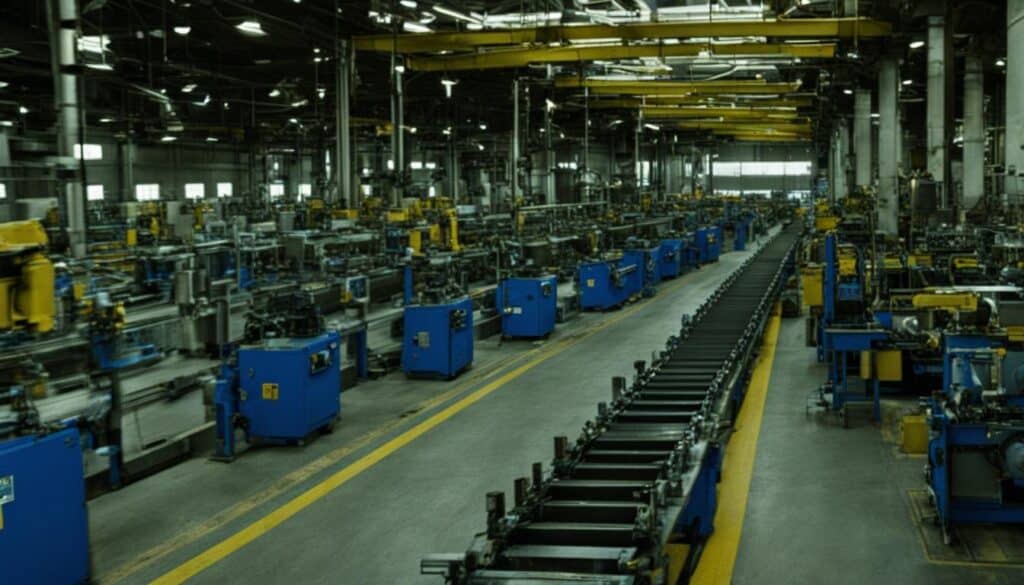Welcome to our article on material management in Singapore. Effective material management plays a crucial role in optimizing efficiency and streamlining business operations. Whether you are a manufacturer or a distributor, having a solid material management strategy can bring significant benefits to your bottom line. In this article, we will explore the importance of material management in Singapore and provide insights into techniques for optimizing manufacturing inventory.
Material management encompasses various processes, including planning, procurement, scheduling, quality control, inventory management, and distribution. By optimizing these processes, businesses can ensure that materials are always in stock, production schedules are met, and costs are reduced, all while maintaining high product quality.
In Singapore, where the manufacturing industry is a significant driver of the economy, efficient material management is crucial for businesses to stay competitive. With the growing demands of customers and the complexity of supply chains, having a robust material management system in place is essential.
By implementing material management best practices and leveraging advanced technologies, businesses in Singapore can enhance their operational efficiency, reduce costs, improve customer satisfaction, and gain a competitive edge in the market.
Stay tuned as we dive deeper into the importance of materials management in manufacturing, techniques for optimizing manufacturing inventory, and the benefits of supply chain optimization software. Let’s embark on a journey to maximize efficiency and success in material management in Singapore.
The Importance of Materials Management in Manufacturing
In the world of manufacturing, efficient materials management is a key driver of success. Without proper materials management, businesses can face disruptions in production, missed deadlines, and dissatisfied customers. To ensure a steady flow of goods for production and meet customer demand, manufacturers need to pay close attention to materials management.
Materials management involves various activities, including managing production requirements, procuring materials, evaluating suppliers, purchasing, scheduling delivery, quality control, and inventory management. By effectively managing these aspects, manufacturers can optimize their production processes and ensure a consistent supply of materials.
One of the primary goals of materials management is to meet production requirements. By carefully planning and monitoring inventory levels, manufacturers can avoid stockouts and production delays. This, in turn, helps them maintain a steady flow of goods and avoid disruptions in the manufacturing process. Additionally, efficient materials management allows manufacturers to meet customer demand in a timely manner, leading to higher customer satisfaction and repeat business.
Another important aspect of materials management is reducing costs. By evaluating suppliers, negotiating favorable contracts, and optimizing inventory levels, manufacturers can minimize procurement expenses and inventory holding costs. This not only improves financial performance but also allows businesses to allocate resources more effectively.
Furthermore, materials management plays a crucial role in maintaining product quality. By implementing rigorous quality control measures and ensuring the availability of high-quality materials, manufacturers can produce goods that meet or exceed customer expectations. This helps build a reputation for reliability and quality, attracting more customers and fostering long-term relationships.
In conclusion, materials management is a critical function in manufacturing. It ensures a steady flow of goods for production, meets customer demand, reduces costs, and maintains product quality. By prioritizing materials management and implementing effective strategies, manufacturers can optimize their operations and achieve sustainable success.
Techniques for Optimizing Manufacturing Inventory
To optimize your manufacturing inventory in Singapore, it is essential to employ various techniques that help streamline your operations and reduce costs. These techniques include demand forecasting, just-in-time inventory, collaborative planning, and material requirements planning.
Demand Forecasting
Demand forecasting plays a crucial role in aligning your production and inventory levels. By accurately predicting customer demand, you can optimize your inventory and avoid stockouts or excess inventory. This technique allows you to plan your procurement or production activities more efficiently, ensuring that you have the right amount of inventory at the right time.
Just-in-Time Inventory
Just-in-time (JIT) inventory management minimizes holding costs by delivering materials or products exactly when needed. With JIT, you can reduce inventory carrying costs and optimize cash flow. This technique relies on close collaboration with suppliers and efficient supply chain management to ensure a steady flow of materials without unnecessary stockpiling.
Collaborative Planning, Forecasting, and Replenishment (CPFR)
Collaborative planning, forecasting, and replenishment (CPFR) is a technique that enhances demand forecasting and supply chain visibility. By actively involving suppliers and partners in the planning process, you can improve the accuracy of demand forecasts and ensure a synchronized flow of materials. This collaborative approach fosters better communication and coordination across the supply chain, reducing inventory discrepancies and delays.
Material Requirements Planning (MRP)
Material requirements planning (MRP) is a technique that utilizes demand forecasts and bills of materials to schedule procurement or production. By integrating your demand forecasts and production plans, you can optimize resource allocation and minimize unnecessary inventory. MRP helps you maintain the right inventory levels at all times, improving production planning and reducing costs.
By implementing these techniques for optimizing manufacturing inventory, you can reduce stockouts, minimize excess inventory, improve production planning, and ultimately lower costs. Additionally, these strategies help enhance your overall supply chain performance and contribute to the efficient operation of your manufacturing business in Singapore.
The Role of JIT and Kanban Systems in Manufacturing Inventory Optimization
In the realm of manufacturing inventory optimization, Just-in-Time (JIT) and Kanban systems play crucial roles. JIT focuses on producing and delivering goods precisely when needed, resulting in reduced excess inventory and carrying costs. This lean production approach helps businesses operate more efficiently and stay responsive to customer demand.
Kanban, on the other hand, employs a visual signaling system to ensure the smooth flow of materials and control throughout the production process. It enables manufacturers to visualize their inventory levels and monitor the status of each item, allowing for better inventory management.
Through the integration of JIT and Kanban systems, manufacturers can eliminate waste, reduce inventory levels, and maintain a pull-based production system. By doing so, they are able to optimize production flow, improve overall efficiency, and ultimately enhance customer satisfaction.
The Importance of Batch Size Optimization in Manufacturing Inventory
Batch size optimization plays a crucial role in optimizing manufacturing inventory in Singapore. By determining the optimal production batch size, you can minimize setup costs and inventory carrying costs, leading to significant savings for your business.
When you produce smaller, more frequent batches, you reduce setup time and resources, resulting in cost savings. This approach also ensures that your inventory levels align with customer demand, reducing storage costs, obsolescence risks, and working capital requirements.
Optimizing batch sizes improves operational efficiency, allowing you to enhance your overall inventory management. By implementing the right batch size optimization strategies, you can effectively optimize your manufacturing inventory, maximize cost-efficiency, and stay ahead in the competitive Singaporean market.
The Benefits of Inventory Segmentation for Manufacturing Inventory Optimization
Inventory segmentation is a powerful technique that helps manufacturers optimize their inventory management strategies and improve overall efficiency. One popular method of inventory segmentation is the ABC analysis, which categorizes inventory items into three categories: A, B, and C.
By conducting an ABC analysis, manufacturers can prioritize and allocate resources effectively based on the value or importance of each inventory item. Category A items, which are typically high-value or high-demand items, receive closer attention and faster replenishment to ensure they are always available when needed. Category B items, on the other hand, receive intermediate management efforts, while Category C items have looser control due to their lower value or demand.
Implementing inventory segmentation through the ABC analysis technique offers several benefits for manufacturing inventory optimization. Firstly, it helps manufacturers identify and focus on the most critical inventory items, ensuring that they are readily available to meet production needs and customer demand. This proactive approach minimizes production delays and improves customer satisfaction.
Secondly, inventory segmentation allows manufacturers to allocate their resources efficiently. By categorizing inventory items, manufacturers can better allocate storage space, working capital, and other resources based on the value or demand of each category. This optimization leads to reduced carrying costs and improved capital utilization.
Furthermore, inventory segmentation enables manufacturers to tailor their inventory management strategies for each category. By implementing different management approaches based on the importance or value of the inventory items, manufacturers can optimize their inventory levels, ordering processes, and replenishment schedules. This targeted approach helps prevent overstocking, stockouts, and excess inventory, ultimately reducing costs and improving overall efficiency.
Overall, inventory segmentation, particularly through the ABC analysis technique, offers manufacturers the opportunity to optimize their inventory management strategies and achieve better control over their manufacturing inventory. By prioritizing and allocating resources effectively, manufacturers can improve efficiency, reduce costs, and ultimately enhance their overall manufacturing inventory performance.
What is Supply Chain Optimization Software?
Supply chain optimization software is a powerful tool that helps businesses streamline and improve their manufacturing supply chain, manage supplier relationships, and optimize crucial business processes. This software is designed to handle key transactions within the supply chain, enabling organizations to effectively manage purchase orders, supplier contracts, customer requests, inventory management, and various demand-sales-distribution-warehousing operations.
By implementing well-integrated supply chain optimization software, businesses can enhance operational activities, accurately predict demand changes, and foster positive relationships with their supply chain partners. This software also provides valuable visibility into the financial management of purchase orders, accounts receivables, and payments throughout the supply chain network.
Why Your Business Needs Supply Chain Optimization Software
When it comes to managing your supply chain, the complexity can be overwhelming. From sourcing raw materials to manufacturing and delivering products, there are multiple moving parts that need to be synchronized for seamless operations. This is where supply chain optimization software comes in.
Supply chain optimization software offers a comprehensive solution for businesses to streamline their supply chain processes, improve inventory management, and enhance overall performance. By integrating every aspect of your supply chain, from sourcing to production and delivery, this software provides a holistic view of your supply chain network.
One of the key benefits of using supply chain optimization software is the ability to improve delivery speed and decrease costs. By identifying operational bottlenecks and optimizing workflows, you can ensure timely deliveries while minimizing unnecessary expenses.
Inventory management is also a critical component of supply chain optimization. With the help of this software, you can gain real-time visibility into your inventory levels, track demand fluctuations, and make data-driven decisions to optimize stock levels. This ensures that you have the right amount of inventory at the right time, reducing unnecessary carrying costs and avoiding stockouts.
By leveraging supply chain optimization software, you can optimize your operations, streamline processes, and enhance your overall supply chain performance. Whether you’re a small business or a large enterprise, this software is designed to meet your specific business needs and navigate the complexities that come with managing a supply chain.
Take control of your supply chain and unlock the potential for improved efficiency and cost savings by harnessing the power of supply chain optimization software.
You can also read our related article on material shortages and how they impact supply chain efficiency.
Top Supply Chain Optimization Software for Your Business
When it comes to optimizing your supply chain, choosing the right software is crucial for achieving efficiency and on-time delivery. Here are some of the top supply chain optimization software options available for businesses in Singapore.
1. HashMicro: With its advanced features and user-friendly interface, HashMicro offers a comprehensive solution for supply chain optimization. This software enhances efficiency by automating processes, providing multi-warehouse support, and enabling accurate sales forecasting.
2. GEODIS: GEODIS is a powerful supply chain optimization software that streamlines operations and improves overall efficiency. It offers real-time visibility, multi-warehouse support, and ensures on-time delivery through effective inventory management and automated workflows.
3. E2open: E2open is a leading software platform that enables businesses to optimize their supply chain operations. It provides end-to-end visibility, collaboration tools, and efficient inventory management, resulting in improved efficiency, cost reduction, and on-time delivery.
4. SAP SCM: SAP SCM is a comprehensive supply chain optimization software that integrates all aspects of the supply chain, from procurement to distribution. It offers advanced analytics, supports multi-warehouse management, and ensures efficient operations for businesses of all sizes.
By leveraging these top supply chain optimization software solutions, businesses in Singapore can reap the benefits of improved efficiency, multi-warehouse support, and on-time delivery. Whether you choose HashMicro, GEODIS, E2open, or SAP SCM, integrating the right software can streamline your processes, enhance overall supply chain performance, and help your business stay ahead of the competition.















